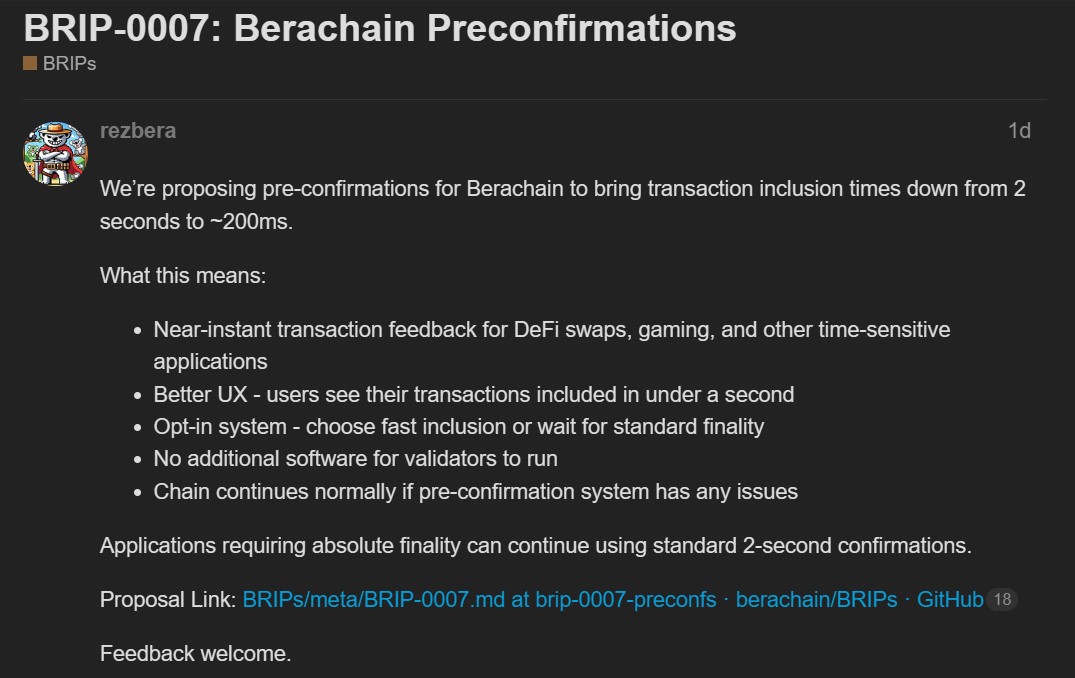Berachain preconfirmations proposal introduces a fast lane mechanism reducing transaction inclusion times to 200 milliseconds, enhancing DeFi and gaming experiences without altering core security. This optional layer provides near-instant feedback while maintaining the network’s two-second finality.
-
Berachain’s BRIP-0007 proposal targets latency-sensitive applications like DeFi swaps and onchain gaming.
-
The preconfirmation system uses a sequencer for partial blocks, delivering real-time transaction visibility.
-
Similar features appear on Ethereum layer-2s and mainnet via platforms like Primev, with Base’s Flashblocks as a recent example; Berachain aims for 200ms inclusion times.
Discover Berachain preconfirmations: Slash transaction times to 200ms for instant DeFi and gaming. Explore the proposal’s impact on blockchain speed and security. Stay ahead in crypto—read now! (148 characters)
What is the Berachain Preconfirmations Proposal?
Berachain preconfirmations refer to a governance initiative, BRIP-0007, designed to accelerate transaction processing on the Berachain network. This proposal introduces an optional preconfirmation layer that reduces inclusion times from two seconds to approximately 200 milliseconds, offering users near-instantaneous feedback for their transactions. By implementing a lightweight sequencer, it enhances user experience in latency-sensitive applications while preserving the blockchain’s fundamental security and consensus mechanisms.
The Berachain community is advancing this proposal to align with industry trends toward faster blockchain interactions. As decentralized networks evolve, reducing perceived latency becomes crucial for competing with centralized Web2 applications. This development positions Berachain as a leader in responsive blockchain technology, particularly for DeFi protocols and interactive Web3 experiences.

Berachain preconfirmations proposal. Source: Berachain
How Do Preconfirmations Work on Berachain?
The preconfirmation mechanism on Berachain operates through a dedicated sequencer that processes and broadcasts partial transaction bundles, known as “partial blocks,” before full block finalization. This allows wallets and decentralized applications to receive confirmation signals in under 200 milliseconds, creating the illusion of instant inclusion without rushing the network’s standard two-second consensus cycle. According to the proposal document from Berachain, this layer remains optional, ensuring users can opt into the fast lane for speed-critical operations while fallback mechanisms maintain stability.
Security is paramount in this design. The sequencer validates transactions temporarily but does not override the core proof-of-stake consensus. If synchronization issues arise, the system seamlessly reverts to the default block production rhythm, preventing any disruption. Data from similar implementations on other networks, such as Ethereum’s layer-2 solutions, indicate that preconfirmations can boost transaction throughput by up to 5x in high-demand scenarios, as reported by Ethereum Foundation researchers. This approach not only minimizes user wait times but also supports scalable growth for DeFi ecosystems.
Experts in blockchain architecture emphasize the proposal’s thoughtful balance. “Preconfirmations represent a pragmatic evolution in layer-1 design, bridging the gap between blockchain reliability and Web2 responsiveness,” noted a lead developer involved in Ethereum scaling discussions, as cited in recent industry analyses. By focusing on partial validations, Berachain avoids the pitfalls of overhauling its consensus engine, which could introduce vulnerabilities.
In practical terms, this means decentralized exchanges on Berachain could execute swaps with immediate visual confirmations, improving trader satisfaction. Onchain gaming benefits similarly, where split-second responses define gameplay. Statistics from Base network’s Flashblocks rollout show a 40% increase in user engagement for interactive apps post-implementation, underscoring the potential impact.
Frequently Asked Questions
What Advantages Does the Berachain Preconfirmations Proposal Offer for DeFi Users?
The Berachain preconfirmations proposal delivers faster transaction feedback, cutting inclusion times to 200 milliseconds, which enhances liquidity provision and trading efficiency in DeFi. Users experience seamless interactions akin to centralized platforms, reducing frustration from delays. This optional feature maintains full security, as confirmed by the network’s governance review process.
How Will Berachain Preconfirmations Impact Onchain Gaming?
Berachain preconfirmations will make onchain gaming feel instantaneous by providing 200-millisecond transaction inclusions for moves and interactions. This reduces lag, enabling competitive play similar to traditional online games. Developers can build more engaging experiences, as the system ensures stability through reversion to standard blocks if needed, supporting reliable gameplay.
Key Takeaways
- Speed Enhancement: Berachain preconfirmations reduce latency to 200ms, ideal for DeFi and gaming without security trade-offs.
- Safety Measures: The design includes fallbacks to the two-second cycle, ensuring network liveness and robustness as per proposal specs.
- Industry Alignment: Joins trends seen in Ethereum layer-2s like Base’s Flashblocks and Primev’s RPC, positioning Berachain competitively.
Conclusion
The Berachain preconfirmations proposal marks a significant step toward ultra-responsive blockchain infrastructure, integrating Berachain preconfirmations to deliver 200-millisecond transaction speeds while upholding security standards. As secondary features like the sequencer layer gain traction, they promise to elevate DeFi usability and Web3 innovation. Blockchain enthusiasts should monitor the governance vote, as its approval could set a new benchmark for network performance—explore Berachain’s ecosystem today to stay informed on emerging opportunities.
Aave DAO proposes $50M annual token buyback using DeFi revenues. This related initiative highlights broader trends in protocol sustainability.
Preconfirmations on other blockchain networks trace back to Ethereum research on soft confirmations. Layer-2 experiments, including Base’s July Flashblocks, and recent Ethereum mainnet advancements via Primev’s RPC demonstrate the growing adoption of fast inclusion systems.






